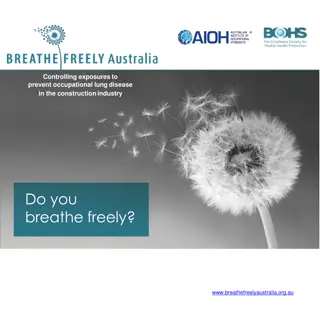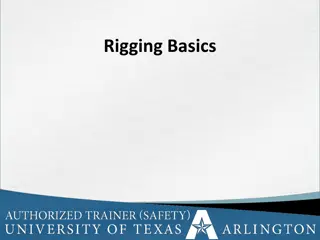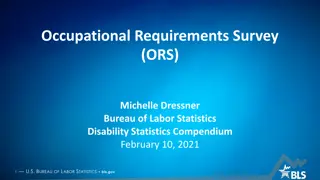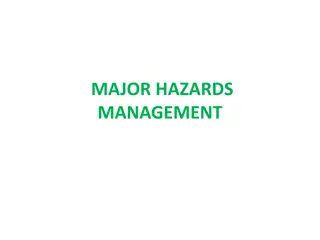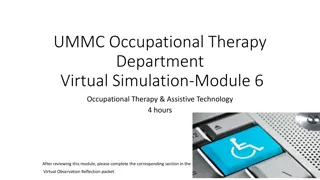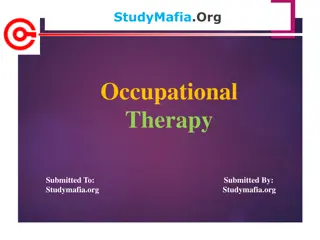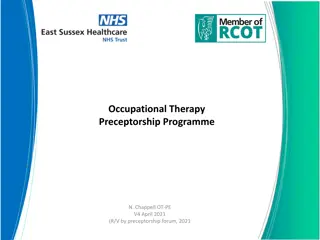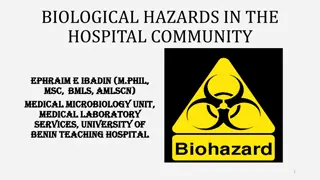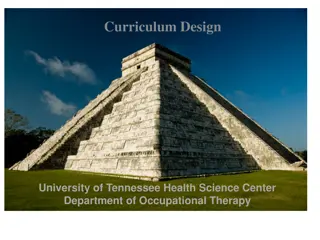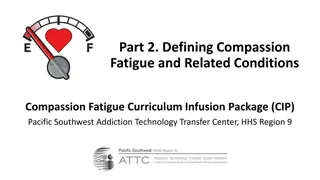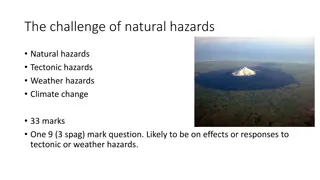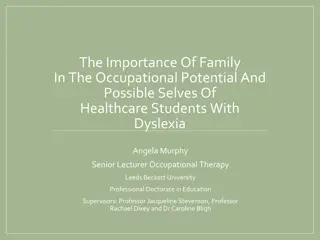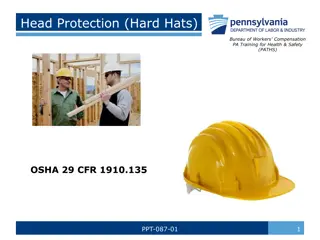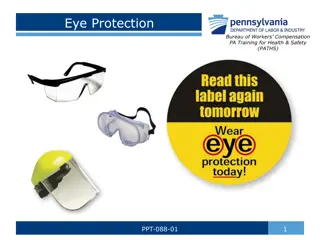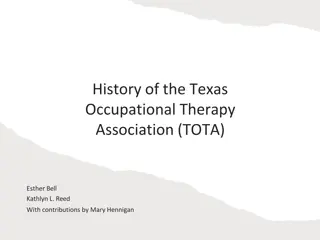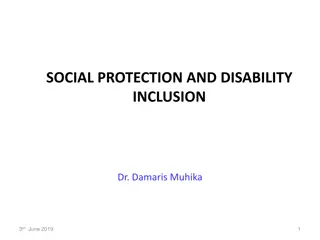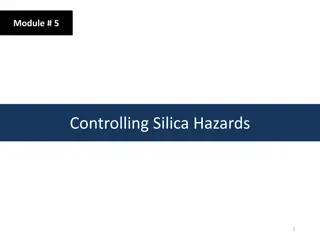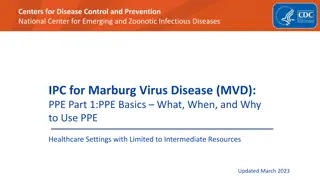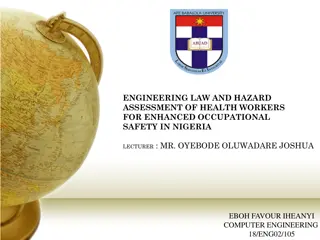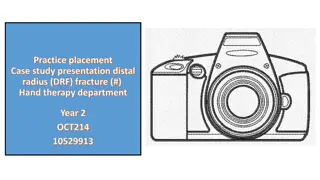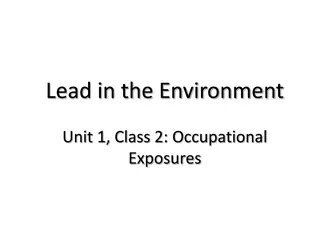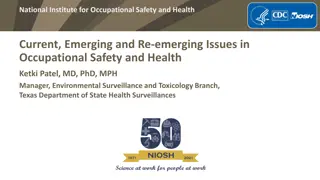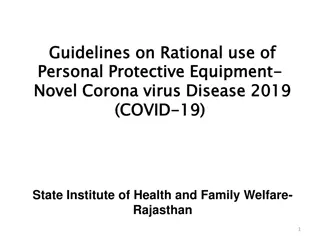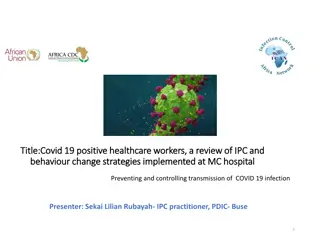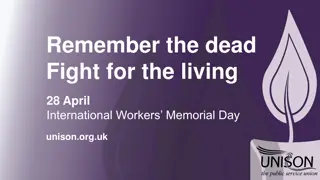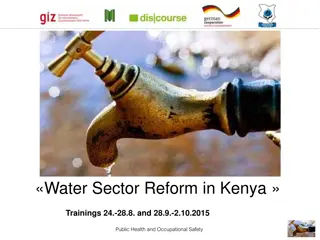Occupational Hazards in Healthcare and Engineering Equipment Development for COVID-19 Protection
Corona Virus, or COVID-19, poses significant health hazards to individuals, especially healthcare workers. This article explores the spread of the virus, types of health hazards, and solutions for prevention. It emphasizes the critical need for developing engineering equipment to support and protect healthcare workers against COVID-19.
Download Presentation

Please find below an Image/Link to download the presentation.
The content on the website is provided AS IS for your information and personal use only. It may not be sold, licensed, or shared on other websites without obtaining consent from the author. Download presentation by click this link. If you encounter any issues during the download, it is possible that the publisher has removed the file from their server.
E N D
Presentation Transcript
ASSESSMENT OF OCCUPATIONAL HAZARDS AND DEVELOPMENT OF ENGINEERING EQUIPMENT TO SUPPORT HEALTH WORKERS AGAINST COVID-19.
OUTLINE What is Corona Virus? How does Corona Virus Spread? What are Health Hazards? Who is a Health Worker? Categories of Health Workers. Occupational Health Hazards. Causes of Occupational Health Hazards. Standard precaution for Health Workers. Solutions and Recommendations to Prevent Health Hazards. Development of Engineering Equipment to Support Health Workers against COVID-19. References.
What is Corona Virus (Covid-19)? Coronavirus disease (COVID-19) is an infectious disease caused by a new virus. The disease causes respiratory illness (like the flu) with symptoms such as a cough, fever, and in more severe cases, difficulty in breathing. You can protect yourself and also prevent the spreading of the disease using the following methods; Wash your hands frequently with soap and water for at least 20 seconds. Use alcoholic hand sanitizers. Avoiding touching your eyes, nose and mouth if your hands are not clean. Keep social distance (1 meter or 3 feet) with other people. Cover your mouth and nose with a tissue or use your sleeve (not your hands) when you cough or sneeze. Put used tissues in the bin immediately and wash your hands. The world Health Organization has declared the COVID-19 outbreak to be a pandemic and this will put the wider health and care services of all nations under extreme pressure. This pressure will inevitably be compounded by staff shortage, it will be a challenge but with the development of engineering equipment to support health care workers this challenge will be responded to rapidly and professionally.
How does Corona Virus Spread? Corona virus (COVID-19) is a respiratory disease that spreads primarily through physical contact with an infected person when they cough or sneeze. It can also be transmitted from person to person through small droplets from the nose or mouth, when an infected person coughs or exhales, these droplets land on objects and surfaces, people get infected with covid-19 by touching infected surfaces or objects that has the virus on it, then touch their eyes, nose, or mouth. It can also be contacted if you breathe in the droplets from a covid-19 patient who coughs out or sneeze droplets.
What are Health Hazards? Health hazard simply means a potential source of danger to a persons health. There are four types of health hazards namely physical, ergonomic, chemical and biological hazards. All these factors in our environment can have negative impacts on our health. Exposure can occur through touch, inhalation and ingestion. In this context we will be looking at ergonomic health hazards, occupational hazards places a strain on a worker s body. Health workers caring for COVID-19 patients have to contend with biological health hazards which includes bacteria, viruses, parasites and molds or fungi. This poses a threat to human health when they are inhaled, eaten or come in contact with the skin. They can cause illness such as food poisoning, tetanus, respiratory infections or parasite infection.
Categories of Health Workers Doctors Nurses Pharmacists Med lab Scientists Radiologists Laboratory personnel Respiratory therapists Cleaners etc.
Occupational health hazards An occupational hazard: is the risk or consequences involved with a particular occupation. Most times mental stress and physical risk are encountered while working in an environment. Physical risk includes any disease or injury whereas mental stress can result from work pressure. Some examples of occupational hazards amongst health workers are; Injuries obtained from the use of sharp objects; such as needle injuries. Infections from patients. Cuts and wounds obtained in the process of performing duties. Airborne diseases. Direct contact with contaminated specimen. Stress. Physical hazards such as slips and falls etc. In relation to Covid-19; health workers can get infection from physical contact with a patient or touching infected surfaces and objects with droplets from an infected person.
Causes of Occupational Hazards Non availability of personal protective equipment (PPE) for health workers. Lack of adequate training on safety measures to be taken by health workers. Unsafe handling, improper cleaning and disinfection of patient care equipment. Ignorance.
Standard Precaution for Health workers. Patient placement with adequate ventilation. Reinforce contact and droplet precautions when caring for all patients with acute respiratory illness and application of standard precautions for all patients. Reinforce airborne precautions for aerosol-generating procedures on all suspected and confirmed COVID-19 patients. Reinforce the rational, correct, and consistent use of personal protective equipment. Health workers should self-monitor temperature and respiratory symptoms daily for 14 days after the last day of exposure to a COVID-19 patient Apply WHO s My 5 Moments for Hand Hygiene before touching a patient, before any clean or aseptic procedure, after exposure to body fluid, after touching a patient, and after touching a patient s surroundings Practice respiratory etiquette at all times.
Solutions and Recommendations to prevent health hazards. Provision of sufficient personal protective equipment(PPE) for all categories of health workers. Health workers should know what PPE they should wear for each setting and context. PPE should be disposed of after each session or earlier if damage, soiled or uncomfortable. Hospitals and Health Centers should provide functional and active occupational safety policy systems. Compulsory seminars and trainings on safety measures to be attended by all clinical and non- clinical staff. Ensure that health workers practice proper personal hygiene such as hand washing and avoid unsafe acts. Hospitals should provide proper ventilation, respirators and ventilators. Provision of sufficient testing kits, running water, disinfectants, anti-bacteria hand wash and hand sanitizers. Health workers undertaking duties in specific care setting/exposure environment should take regular breaks or rest periods and leave the area at end of the task or session. Risk assessment of the session should always be considered where there are high rates of cases. It is recommended that during transportation of patients, suspected or confirmed cases should wear surgical face mask to minimize the dispersal of respiratory secretions, reduce both direct transmission risk and environmental contamination. Surgical face mask should not be worn by patients receiving oxygen therapy.
Development of Engineering Equipment to Support Health Workers against COVID-19. Engineers have developed robots to treat and test COVID-19 patients in a bid to protect health workers. The remote controlled machine can take mouth swabs, perform ultrasound scans and listen to organs with a robot stethoscope while allowing health care workers to operate at a safe distance from the highly infectious virus using onboard cameras to monitor the patient. Engineers have designed and manufactured machines for production of personal protection equipment (PPE) to protect health workers from infection by the virus. These PPE are designed to protect the skin, eyes, mucous membranes , airways and clothing from coming in contact with the infectious agents such as COVID-19. The PPE includes; medical mask, disposable and heavy duty gloves, disposable apron and gown, eye protection(goggles and face shield), Boots and Respirators. As an engineer I would design and create an equipment that can ensure adequate infectious waste disposal and management systems . Engineers develop devices that provides proper ventilation to replace stale air with fresh air, this helps to moderate internal temperatures, humidity and reduces the accumulation of poisonous gases, bacteria, odor and other contaminants that can build up thereby inhibits the spread of respiratory diseases.
References 1. WHO considerations for quarantine of individuals in the context of containment for coronavirus disease (COVID-19): Interim guidance 28 February 2020 2.WHO occupational health a guideline for primary health care workers. 3.COVID-19 NHS England.


